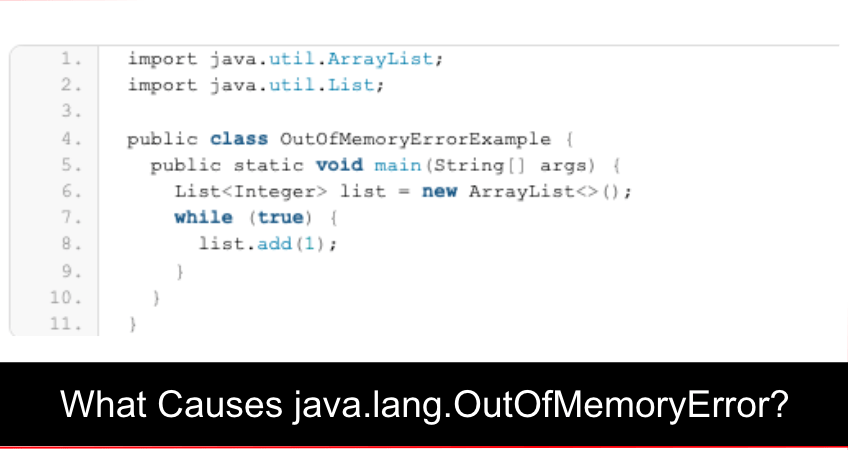What Causes java.lang.OutOfMemoryError?
Java.lang.OutOfMemoryError is a common error that can occur in a Java application. It occurs when the Java Virtual Machine (JVM) runs out of memory and is unable to allocate any more memory to the application. There are several common causes of this error:
- Memory leaks: If your application has a memory leak, it may continue to allocate new objects and use more memory even when they are no longer needed. Over time, this can cause the Java heap to fill up and run out of memory.
- Large data sets: If you are working with very large data sets, your application may need a lot of memory to store and process the data. If the Java heap is not large enough, you may run out of memory.
- Insufficient heap size: By default, the Java heap has a fixed size that is determined by the JVM. If your application requires more memory than the default heap size, you may run out of memory. You can increase the heap size by using the -Xmx command-line option when starting the JVM.
- Poor memory management: If you are not using memory efficiently in your application, you may run out of memory even if you have a large heap size. You can optimize your application’s memory usage by choosing algorithms and data structures that use memory efficiently.
Here is a simple Java program that will cause an OutOfMemoryError
import java.util.ArrayList;
import java.util.List;
public class OutOfMemoryErrorExample {
public static void main(String[] args) {
List<Integer> list = new ArrayList<>();
while (true) {
list.add(1);
}
}
}
This program creates a list of integers and then adds a new integer to the list in an infinite loop. This will cause the Java heap to fill up and eventually run out of memory, resulting in an OutOfMemoryError.
To run this program, you will need to increase the maximum heap size by using the -Xmx command-line option when starting the JVM. For example, to set the maximum heap size to 2GB, you can use the following command:
java -Xmx2g OutOfMemoryErrorExample
This will allow the program to run for longer before running out of memory, but it will eventually throw an OutOfMemoryError.
What does Java do to avoid OutOfMemoryErrors
Java has several mechanisms in place to avoid OutOfMemoryError and other runtime errors:
- Garbage collection: Java uses a garbage collector to periodically reclaim the application’s memory that is no longer being used. The garbage collector runs in the background and removes objects that are no longer reachable, freeing up memory for reuse.
- Automatic heap expansion: If the garbage collector is unable to free up enough memory to satisfy a request for more memory, the Java heap will automatically expand to try to accommodate the request. This can help prevent OutOfMemoryError by allowing the application to continue running even if the heap fills up.
- OutOfMemoryError threshold: The Java heap has a maximum size that is determined by the JVM. If the heap expands to reach this maximum size and the garbage collector is still unable to free up enough memory, an OutOfMemoryError will be thrown. This safeguard prevents the application from consuming all available memory on the system.
By using these mechanisms, Java can help prevent OutOfMemoryError and other runtime errors from occurring in your application. However, it is still important to design and implement your application in a way that avoids excessive memory usage and other performance issues.
How to find a java.lang.OutOfMemoryError
To find a java.lang.OutOfMemoryError in a Java application, you can use a combination of the following methods:
- Check the logs: The JVM will typically log an OutOfMemoryError message when it occurs. Check the application’s log files for any error messages related to OutOfMemoryError or use a log monitoring tool.
- Use a heap dump: A heap dump is a snapshot of the heap at a specific point in time. You can use a heap dump to analyze the heap and identify the objects that are causing the OutOfMemoryError.
- Use a profiler: A memory profiler is a tool that can be used to analyze the performance of a Java application. It can be used to identify the parts of the code that are causing an OutOfMemoryError.
- Monitor memory usage: Use an Application Performance Management (APM) tool to monitor the application’s memory usage. This can help you identify any abnormal increase in memory usage that may indicate an OutOfMemoryError.
- Analyze the heap dump with a memory analyzer tool: Once you have a heap dump, you can use a memory analyzer tool to analyze the heap dump and identify the objects that are causing the OutOfMemoryError.
- Analyze the thread dump: Thread dump contains the stack trace of all the threads running in the JVM. Analyze the thread dump to identify the thread that is responsible for the OutOfMemoryError.
Once you have identified the cause of the OutOfMemoryError, you can take appropriate action to resolve the issue, such as increasing the heap size, fixing memory leaks, optimizing the code, or upgrading to a newer version of the JVM that has better memory management capabilities.
Conclusion – What Causes java.lang.OutOfMemoryError?
To resolve this error, it’s important to identify the cause of the issue and take appropriate action. This can include increasing the heap size, fixing memory leaks, optimizing the code, reducing the number of objects created, or upgrading to a newer version of the JVM that has better memory management capabilities. An Application Performance Management (APM) tool like FusionReactor can be helpful to monitor the memory usage and detect potential issues.










